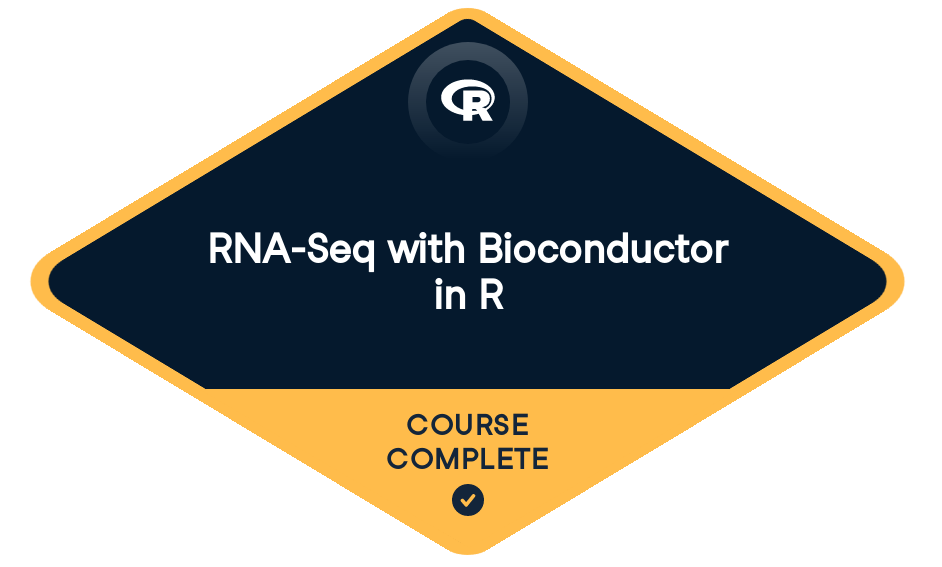Md. Tabassum Hossain Emon has completed
RNA-Seq with Bioconductor in R
Start course For Free4 hr
3,150 XP

Loved by learners at thousands of companies
Course Description
RNA-Seq is an exciting next-generation sequencing method used for identifying genes and pathways underlying particular diseases or conditions. As high-throughput sequencing becomes more affordable and accessible to a wider community of researchers, the knowledge to analyze this data is becoming an increasingly valuable skill. Join us in learning about the RNA-Seq workflow and discovering how to identify which genes and biological processes may be important for your condition of interest! We will start the course with a brief overview of the RNA-Seq workflow with an emphasis on differential expression (DE) analysis. Starting with the counts for each gene, the course will cover how to prepare data for DE analysis, assess the quality of the count data, and identify outliers and detect major sources of variation in the data. The DESeq2 R package will be used to model the count data using a negative binomial model and test for differentially expressed genes. Visualization of the results with heatmaps and volcano plots will be performed and the significant differentially expressed genes will be identified and saved.
Training 2 or more people?
Get your team access to the full DataCamp platform, including all the features.- 1
Introduction to RNA-Seq theory and workflow
FreeIn this chapter we explore what we can do with RNA-Seq data and why it is exciting. We learn about the different steps and considerations involved in an RNA-Seq workflow.
- 2
Exploratory data analysis
In this chapter, we perform quality control on the RNA-Seq count data using heatmaps and principal component analysis. We explore the similarity of the samples to each other and determine whether there are any sample outliers.
Introduction to differential expression analysis50 xpPractice with the DESeq2 vignette50 xpOrganizing the data for DESeq250 xpMatching metadata and counts data100 xpCount normalization50 xpNormalizing counts with DESeq2100 xpHierarchical heatmap50 xpHierarchical heatmap by condition100 xpHierarchical heatmap analysis50 xpPrincipal component analysis50 xpPCA analysis100 xpPCA practice: exploring variations50 xpPCA practice: exploring additional variations50 xp - 3
Differential expression analysis with DESeq2
In this chapter, we execute the differential expression analysis, generate results and identify the differentially expressed genes.
DE analysis50 xpCreating the DE object100 xpDESeq2 model - dispersion50 xpDESeq2 model - exploring dispersions100 xpInterpreting the dispersion plot50 xpDESeq2 model - contrasts50 xpDESeq2 model - extracting results100 xpDESeq2 results - LFC shrinkage100 xpDESeq2 results50 xpDESeq2 results exploration100 xpSummarizing DESeq2 results100 xpDESeq2 significant results100 xp - 4
Exploration of differential expression results
In this final chapter we explore the differential expression results using visualizations, such as heatmaps and volcano plots. We also review the steps in the analysis and summarize the differential expression workflow with DESeq2.
Visualization of results50 xpDESeq2 visualizations - MA and volcano plots100 xpDESeq2 visualizations - heatmap100 xpRNA-Seq DE analysis summary - setup50 xpRNA-Seq DE analysis - experimental planning50 xpRNA-Seq DE workflow summary100 xpRNA-Seq DE analysis summary50 xpDE analysis100 xpDE analysis results100 xpRNA-Seq next steps50 xp
Training 2 or more people?
Get your team access to the full DataCamp platform, including all the features.datasets
Fibrosis raw counts datasetcollaborators



Bioinformatics Consultant and Trainer
Mary Piper serves dual roles as research analyst and bioinformatics trainer in the Department of Biostatistics at the Harvard T.H. Chan School of Public Health. However, her primary role is the development and instruction of bioinformatics workshops focused on the analysis of next-generation sequencing data. She has a PhD in cellular and molecular biology from the University of Michigan and a background in science education. Her passion for bioinformatics research and teaching led to her desire to pursue bioinformatics as a career and to share that knowledge with the community.
Join over 18 million learners and start RNA-Seq with Bioconductor in R today!
Create Your Free Account
or
By continuing, you accept our Terms of Use, our Privacy Policy and that your data is stored in the USA.